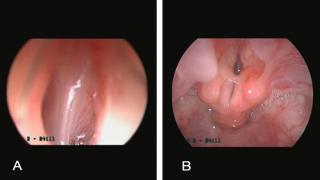C’est la plus rare et la plus grave des malformations congénitales du larynx. La malformation résulte d'un développement embryologique anormal du larynx, et de la résorption incomplète de la couche épithéliale qui comble normalement la lumière du larynx à la sixième semaine du développement. Cette couche épithéliale est habituellement éliminée à la dixième semaine. L'involution allant de la face dorsale vers la face ventrale, les membranes laryngées sont antérieures, laissant une lumière postérieure de taille variable. Le mode de la transmission est compatible avec un gène dominant autosomique. Elle peut être isolée ou s'intégrer dans le cadre d'un syndrome polymalformatif comme la microdélétion du chromosome 22 (voir CATCH 22) le syndrome de Fraser (voir ce terme).
On distingue 3 types d'atrésie laryngée (parfois associée à une fistule œso-trachéale ou à un syndrome de VACTERL) :
- I : atrésie complète, supra- et infraglottique, avec absence de cordes vocales et fusion médiane des cartilages aryténoïdes;
- II : infraglottique ; les cordes vocales et les aryténoïdes sont normaux mais le cartilage cricoïde obstrue la lumière ;
- III : membrane au niveau des processus vocaux parfois accompagnée d’une fusion des cartilages aryténoïdes : la glotte est occupée par du tissu fibreux. La palmure laryngée congénitale (voir ce terme) est considérée comme une forme mineure d’atrésie laryngée.
Un examen cardiovasculaire complet doit être fait, à la recherche d'anomalies des arcs aortiques.

Implications anesthésiques:
difficultés de ventilation et ou d’intubation ; prévoir un masque laryngé pour ventiler et différentes sondes de très faible diamètre pour franchir la sténose (sonde urétérale). Trachéotomie en urgence.
Références:
- Garg MK.
Case report: Antenatal diagnosis of congenital high airway obstruction syndrome - laryngeal atresia.
Indian J Radiol Imaging. 2008 ; 18(4):350-1.
- Hoka S, Sato M, Yoshitake J, Kukita J.
Management of a newborn infant with congenital laryngeal atresia.
Anesth Analg 1989; 69: 535-6.
- Shimabukuro F, Sakumoto K, Masamoto H, Asato Y, Yoshida T, Shinhama A, Okubo E, Ishisoko A, Aoki Y.
A case of congenital high airway obstruction syndrome managed by ex utero intrapartum treatment: case report and review of the literature.
Am J Perinatol. 2007; 24:197-201.
- Kohl T, Van de Vondel P, Stressig R, Wartenberg HC, Heep A, Keiner S, Müller A, Franz A, Fröhlich S, Willinek W, Gembruch U.
Percutaneous fetoscopic laser decompression of congenital high airway obstruction syndrome (CHAOS) from laryngeal atresia via a single trocar--current technical constraints and potential solutions for future interventions.
Fetal Diagn Ther 2009; 25:67-71.
- Wyatt ME, Hartley BE.
Laryngotracheal reconstruction in congenital laryngeal webs and atresias.
Otolaryngol Head Neck Surg 2005; 132:232-8.
- Okumus N, Onal EE, Turkyilmaz C, Biri A, Gonul II, Unal S, Poyraz A, Atalay Y.
Resuscitation failure due to Fraser syndrome in a newborn undiagnosed in the prenatal period.
Resuscitation 2005; 65:221-3.
- Soni L, Prasad G, Kaur M.
A case of antenatally undiagnosed laryngeal atresia with tracheoesophageal fistula with airway obstruction at birth and its management.
Pediatr Anesth. 2024;34:175-177.
Mise à jour: janvier 2024